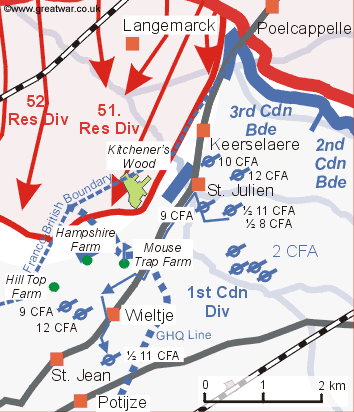 3rd Brigade Canadian Field Artillery batteries withdraw
3rd Brigade Canadian Field Artillery batteries withdraw
22 April 1915: 21.00
From 5pm to 8pm the 9th, 11th and 12th Batteries of the Canadian Field Artillery (CFA) had fired continuously onto the German front trenches. At 9pm the order was given by the commander of the 1st Canadian Divisional Artillery, Brigadier-General H W Burstall, for all four Canadian field batteries from 3rd Brigade CFA (i.e. 9th, 10th, 11th and 12th) to withdraw. In their current positions north-east, east, south-east and south of St. Julien they were under 1,000 metres from the German advancing infantry. The order was to move to the north of St. Jean so as to be able to cover Kitchener's Wood. The 3rd Brigade CFA commander, Lieutenant-Colonel J H Mitchell, ordered the four batteries to rendezvous at the crossroads near Hill Top Farm, to the south-west of Mouse Trap Farm.
9th and 12th Batteries
The 9th and 12th Batteries managed to make their way to the rendezvous point south of Hill Top Farm by midnight.
11th Battery

Half of the 11th Battery was made up of a detached section of 8th Battery from the 2nd Canadian Field Artillery Brigade. Unfortunately, the teams to withdraw the section of the 8th Battery did not receive correct instructions, insofar as they were misdirected. That section of 8th Battery remained in the original position throughout the next day.
The section of the 11th Battery successfully moved out of its position south-west of St. Julien. It made its way through St. Julien to a position about 400 metres south of Hampshire Farm. However, it was under machine gun and shellfire here and was again moved to a location near Potijze Chateau.
10th Battery
The battery was located in an orchard behind the hamlet of Keerselaere, about 450 metres north of St. Julien and 90 metres east of the St. Julien-Poelcappelle road. The limbers were located a little further south of the battery in a shell-hole beside the Haanebeek stream. 10th Battery was commanded by Major W B M King.
At about 6.30pm the German advance towards St. Julien had been brought to a halt. The stubborn defence of the 13th Canadian Battalion on the left of the Canadian line was assisted by the artillery fire of two of the guns from the 10th Battery (10 CFA on map refers). The battery had opened fire at 5.45pm. Some of the gas had wafted through the battery position.
The position of this gun battery became threatened as the German advance began to put pressure on the the French and Canadian troops holidng a position along the St. Julien-Poelcappelle road. At one point, at about 7pm, a large number of German helmets were seen bobbing above a hedge as they marched southwards only about 200 metres away from the battery position. Major King swung two of his guns round to face the west and continued firing intermittantly in two directions - to the west and to the north. Leaves and branches fell down on the gun crews as German machine gun bullets rained down on the orchard from close range. Fortunately for the battery the German machine gun fire died down and the Germans withdrew a little way and dug in.
The 10th Battery was in the most dangerous position as it was closest to the advancing enemy. Unfortunately the teams of men in the ammunition wagons had been killed west of St. Julien whilst on their way to resupply the battery. The wagons had been ditched and, with the help of 30 men from 7th Canadian Battalion and 25 men from 2nd Company 15th Canadian Battalion, the ammunition rounds had been carried by hand some 500 metres further on to the battery position.
The battery commander, Major King, was unsure if the limbers would be able to reach him unscathed and in time. So he ordered two first line transport wagon teams to pull two of the four guns to the rendezvous point south-west of Mouse Trap Farm. Forty-five minutes after the first two guns had left the position there was still no sign of the battery's limbers. He therefore ordered the remaining two guns to be hooked up to wagon limbers. To Major King's relief, at about 11pm the battery's limbers did eventually arrive and the two guns and remaining wagons were removed from the position.
By the early hours of 23 April all four guns of the10th Battery had been moved out of the line, through the Canadian Division rear area and had crossed over the Yser Canal to the west bank. It was put into position near Brielen under command of the 1st Canadian Divisional Artillery.
Next>> The gallantry of Lance-Corporal Fred Fisher, VC
Acknowledgements
Official History of the Canadian Forces in The Great War 1914-1919, pp. 235, 242-244